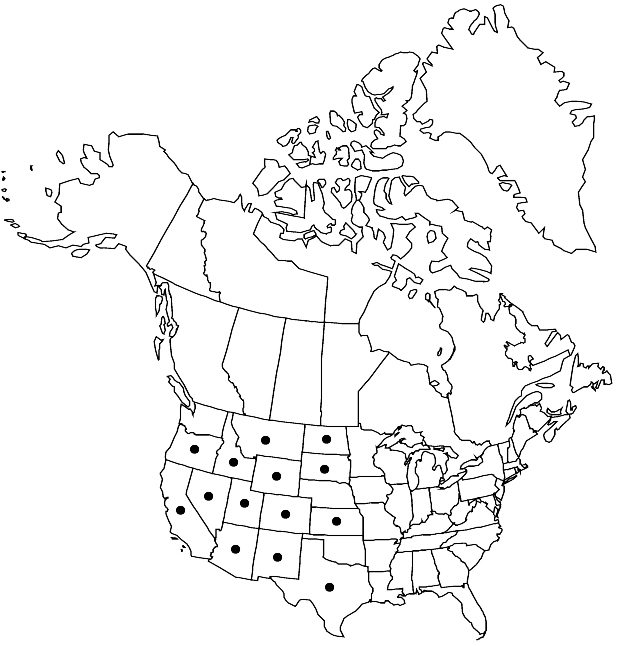Difference between revisions of "Stanleya pinnata"
Trans. New York Acad. Sci. 8: 62. 1889.
FNA>Volume Importer |
RevisionBot (talk | contribs) m (Bot: Adding category Revised Since Print) |
||
| (4 intermediate revisions by 3 users not shown) | |||
| Line 6: | Line 6: | ||
|place=8: 62. 1889 | |place=8: 62. 1889 | ||
|year=1889 | |year=1889 | ||
| + | }} | ||
| + | |special_status={{Treatment/ID/Special_status | ||
| + | |code=E | ||
| + | |label=Endemic | ||
}} | }} | ||
|basionyms={{Treatment/ID/Basionym | |basionyms={{Treatment/ID/Basionym | ||
| Line 25: | Line 29: | ||
-->{{Treatment/Body | -->{{Treatment/Body | ||
| − | |distribution= | + | |distribution=Ariz.;Calif.;Colo.;Idaho;Kans.;Mont.;N.Dak.;N.Mex.;Nev.;Oreg.;S.Dak.;Tex.;Utah;Wyo. |
|discussion=<p>Varieties 3 (3 in the flora).</p><!-- | |discussion=<p>Varieties 3 (3 in the flora).</p><!-- | ||
--><p>The three varieties of <i>Stanleya pinnata</i> are reasonably well-defined and can be easily separated from each other. Their maintenance here at varietal rank is tentative; a genus-wide phylogenetic study is much needed to establish whether or not they merit recognition as distinct species.</p> | --><p>The three varieties of <i>Stanleya pinnata</i> are reasonably well-defined and can be easily separated from each other. Their maintenance here at varietal rank is tentative; a genus-wide phylogenetic study is much needed to establish whether or not they merit recognition as distinct species.</p> | ||
| Line 67: | Line 71: | ||
|basionyms=Cleome pinnata | |basionyms=Cleome pinnata | ||
|family=Brassicaceae | |family=Brassicaceae | ||
| − | |distribution= | + | |distribution=Ariz.;Calif.;Colo.;Idaho;Kans.;Mont.;N.Dak.;N.Mex.;Nev.;Oreg.;S.Dak.;Tex.;Utah;Wyo. |
|reference=lichvar1983a | |reference=lichvar1983a | ||
|publication title=Trans. New York Acad. Sci. | |publication title=Trans. New York Acad. Sci. | ||
|publication year=1889 | |publication year=1889 | ||
| − | |special status= | + | |special status=Endemic |
| − | |source xml=https:// | + | |source xml=https://bitbucket.org/aafc-mbb/fna-data-curation/src/2e0870ddd59836b60bcf96646a41e87ea5a5943a/coarse_grained_fna_xml/V7/V7_1202.xml |
|tribe=Brassicaceae tribe Thelypodieae | |tribe=Brassicaceae tribe Thelypodieae | ||
|genus=Stanleya | |genus=Stanleya | ||
| Line 78: | Line 82: | ||
}}<!-- | }}<!-- | ||
| − | -->[[Category:Treatment]][[Category:Stanleya]] | + | --> |
| + | |||
| + | [[Category:Treatment]] | ||
| + | [[Category:Stanleya]] | ||
| + | [[Category:Revised Since Print]] | ||
Latest revision as of 17:16, 6 November 2020
Perennials, subshrubs, or shrubs; (sometimes suffrutescent); (glaucous or not), mostly glabrous. Stems erect, unbranched or branched (few) proximally and distally, (1.2–)3–12(–15.3) dm. Basal leaves (withered by flowering); similar to cauline. Cauline leaves: petiole 0.7–6.2 cm; blade (fleshy), oblanceolate to broadly lanceolate or ovate in outline, or (distally) lobed or linear to narrowly lanceolate, 3–15 cm (smaller distally), margins lyrate-pinnatifid or runcinate, or (distal) pinnately lobed or entire. Racemes somewhat dense. Fruiting pedicels horizontal to divaricate, 3–11 mm. Flowers: sepals oblong-linear, 8–16 mm; petals yellow, oblanceolate to oblong, 8–20 × 2–3 mm, claw 4–10 mm, wider at base, densely pubescent inside; filaments 11–28 mm, pilose at base; anthers 3–5 mm; gynophore 7–28 mm. Fruits usually spreading to divaricate, rarely ascending, often strongly curved downward, not tortuous, (smooth), terete, 3–9 cm × 1.5–3 mm; ovules 10–38 per ovary; style 0.2–0.6 mm. Seeds (sometimes black), oblong, 2.5–4.5 × 1.2–2 mm.
Distribution

Ariz., Calif., Colo., Idaho, Kans., Mont., N.Dak., N.Mex., Nev., Oreg., S.Dak., Tex., Utah, Wyo.
Discussion
Varieties 3 (3 in the flora).
The three varieties of Stanleya pinnata are reasonably well-defined and can be easily separated from each other. Their maintenance here at varietal rank is tentative; a genus-wide phylogenetic study is much needed to establish whether or not they merit recognition as distinct species.
Selected References
Lower Taxa
Key
| 1 | Cauline leaf blades: margins (at least proximal ones) lyrate-pinnatifid to runcinate. | Stanleya pinnata var. pinnata |
| 1 | Cauline leaf blades: margins usually entire, rarely proximalmost dentate | > 2 |
| 2 | Cauline leaf blades ovate to lanceolate; petals 11-16 mm, claws 6-9 mm; ovules 26-34 per ovary; gynophores pubescent basally; Colorado, Kansas, Nevada, Utah, Wyoming. | Stanleya pinnata var. integrifolia |
| 2 | Cauline leaf blades linear-lanceolate; petals 8-9(-10) mm, claws 4-5 mm; ovules 10-20 per ovary; gynophores glabrous or nearly so; Texas. | Stanleya pinnata var. texana |